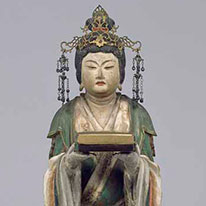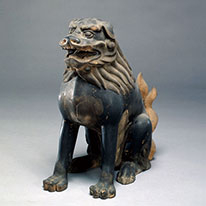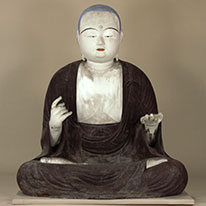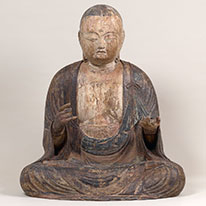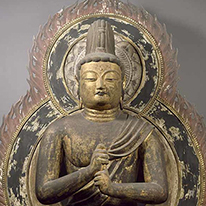Past Exhibitions
- Feature Exhibition Shinto Deities and Guardian Lions and Lion-Dogs
- January 2, 2020 - February 26, 2020
How did the early Japanese represent the kami, their indigenous Shinto gods? When shown in human forms, these deities were often represented as refined aristocrats, but they are also shown as armor-wearing figures with fierce expressions or in other ways. Typically, the Shinto shrines dedicated to such kami are guarded by a pair of lion and lion-dog. The lion, on the right, has its mouth open, while the horned lion-dog on the left has its mouth closed. These guardian animals were depicted in various ways that changed over time. This exhibition features rare early statues of Shinto deities and protective beasts, giving visitors a unique opportunity to view sacred representations that differ from Buddhist images.
- Special Viewing in Commemoration of the Restoration Completion:
Seated Bodhisattva Jizō (Kṣitigarbha) from Zenpuku-ji Tmeple, Maizuru City - January 2, 2020 – February 26, 2020, 2020
To commemorate the restoration of the seated bodhisattva Jizō (Kṣitigarbha) from Zenpuku-ji Temple in Maizuru City, the statue will be displayed for special viewing. Except for partial repainting, it has been restored almost to its original state.
While the temple is said to have been built in 1417, inscriptions found inside the Jizō statue reveal that it was made in 1175, predating the founding of the temple. Around fifty donors from the regions of Tanba and Tango (present-day Hyogo and Kyoto prefectures) are listed, making it an invaluable piece to trace the local history.
- Japanese Sculpture
- January 2, 2020 – February 26, 2020
What do Japanese sculptures depict? Before the Edo period, almost all Japanese statues were of deities or religious figures. Buddhist sculptures have been produced in Japan since Buddhism came to the archipelago in the seventh century. Japanese Buddhist deities often have origins in South Asia and the Himalayas. These were usually imported into Japan by way of China, bringing foreign influences with them.
One of the distinctive characteristics of Japanese sculpture is its use of wood as a primary material. Various modes of carving and other techniques—including joint-block construction (yosegi-zukuri) and inlaid crystal eyes—were developed in Japan to create these wood images.
The Japanese Buddhist sculptures on view here come from different historical periods. Their varied styles exemplify the repeated waves of influence from the Asian mainland as well as subsequent Japanese innovations.











